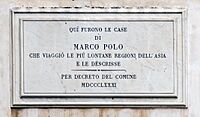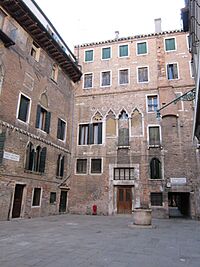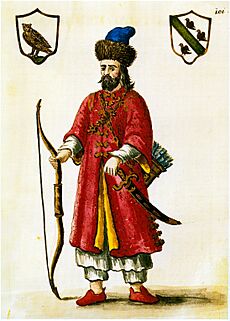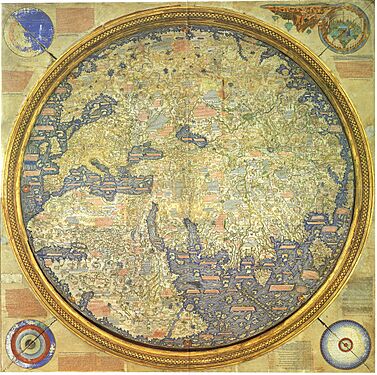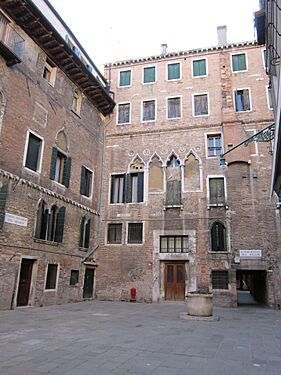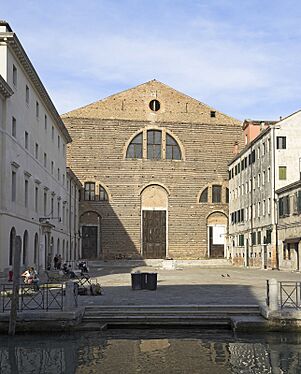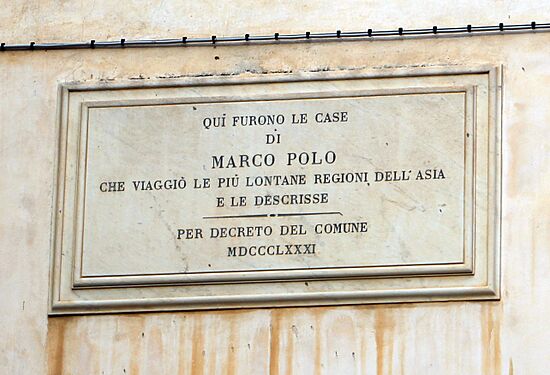Marco Polo facts for kids
Quick facts for kids
Marco Polo
|
|
|---|---|
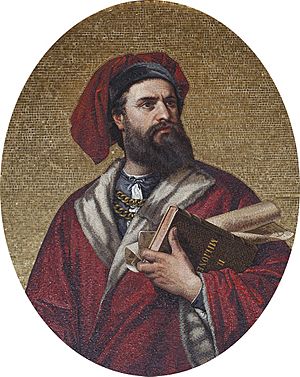
|
|
| Born | 1254 |
| Died | 8 January 1324 (aged 69–70) Venice, Republic of Venice
|
| Resting place | Church of San Lorenzo |
| Occupation |
|
| Known for | The Travels of Marco Polo |
| Spouse(s) |
Donata Badoer
(m. 1300) |
| Children | 4, including Fantina |
| Parent(s) |
|
Marco Polo (born around 1254 – died 8 January 1324) was a Venetian merchant, explorer, and writer. He traveled across Asia using the famous Silk Road between 1271 and 1295. His amazing adventures are written down in a book called The Travels of Marco Polo (also known as Book of the Marvels of the World or Il Milione), which came out around 1300.
This book gave Europeans their first detailed look into the mysterious Eastern world, including the huge and wealthy Mongol Empire and China under the Yuan dynasty. It described places like China, Persia (modern-day Iran), India, and Japan, which were largely unknown to Europeans at the time.
Marco was born in Venice. He learned how to be a merchant from his father, Niccolò Polo, and his uncle, Maffeo, who had already traveled through Asia and even met Kublai Khan, the powerful Mongol ruler. In 1269, Niccolò and Maffeo returned to Venice and met Marco for the first time.
In 1271, the three of them began an incredible journey to Asia. They explored many places along the Silk Road until they reached "Cathay" (China). Kublai Khan was very impressed by Marco's intelligence and humble nature. Marco was chosen to work for Kublai as a foreign ambassador, meaning he traveled on many important missions throughout the empire and Southeast Asia. He visited places like modern-day Myanmar, India, Indonesia, Sri Lanka, and Vietnam.
Marco lived in China for 17 years, seeing many things that Europeans had never known about. Around 1291, the Polos offered to go with the Mongol princess Kököchin to Persia. They arrived there around 1293. After leaving the princess, they traveled overland to Constantinople (modern-day Istanbul) and then finally back to Venice in 1295, after 24 years away!
When they returned, Venice was at war with Genoa. Marco joined the fight for Venice and was captured by the Genoese. While in prison, he told the stories of his travels to a cellmate named Rustichello da Pisa, who wrote them down. Marco was released in 1299, became a rich merchant, got married, and had three children. He died in 1324 and was buried in the church of San Lorenzo in Venice.
Even though he wasn't the very first European to reach China, Marco Polo was the first to write such a detailed account of his experiences. His book gave Europeans a clear picture of the geography and cultures of the East. It also included the first Western descriptions of things like porcelain, gunpowder, paper money, and some unique Asian plants and animals. His stories inspired many future explorers, including Christopher Columbus. His writings also influenced European mapmaking, leading to important maps like the Catalan Atlas and the Fra Mauro map.
Marco Polo: The Famous Explorer
Early Life and Family
Marco Polo was born around 1254 in Venice, but the exact date and place aren't known for sure. His famous book, The Travels of Marco Polo, tells us some basic things about his family. It says that Marco's father, Niccolò Polo, who was a traveling merchant, came back to Venice around 1269. He found out that his wife, whom he had left pregnant, had died, leaving behind their 15-year-old son, Marco.
While most people agree Marco was born in Venice, some theories suggest he might have been born on the island of Korčula or in Constantinople. However, most experts don't believe these ideas.
Why Was He Called 'Milione'?
During his lifetime, Marco Polo was nicknamed Milione, which means 'Million' in Italian. The Italian title of his book was Il Libro di Marco Polo soprannominato Milione, meaning "The Book of Marco Polo, nicknamed 'Milione'". According to a writer from the 15th century, Giovanni Battista Ramusio, his fellow citizens gave him this nickname when he returned to Venice because he kept talking about Kublai Khan's wealth, saying it was counted in millions. More specifically, they called him Messer Marco Milioni (Mr. Marco Millions).
However, since his father Niccolò was also called Milione, some experts in the 19th century thought that Milione might have been a shorter version of Emilione. They believed this nickname was used to tell Niccolò's and Marco's family branch apart from other Polo families.
An Epic Journey to Asia

Marco's father, Niccolò Polo, and his uncle, Maffeo Polo, were successful merchants who traded with the Near East. They became very wealthy and respected. Before Marco was born, Niccolò and Maffeo went on a trading trip. In 1260, while living in Constantinople, they sensed political changes were coming. They sold their goods for jewels and moved away. According to The Travels of Marco Polo, they traveled through much of Asia and met Kublai Khan, the Mongol ruler and founder of the Yuan dynasty.
We don't know much about Marco Polo's childhood until he was fifteen. He likely spent part of it in Venice. His mother died, and an aunt and uncle raised him. He received a good education for a merchant, learning about foreign money, how to value goods, and how to manage cargo ships. He didn't learn much, if any, Latin. His father later married Floradise Polo.
In 1269, Niccolò and Maffeo returned to Venice and met young Marco for the first time. In 1271, when Marco was seventeen, he, his father, and his uncle set off for Asia on the incredible adventures that Marco later wrote about in his book.
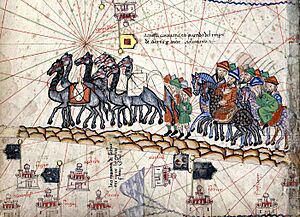
They sailed to Acre and then rode camels to the Persian port of Hormuz. The Polos wanted to sail directly to China, but the ships there weren't safe for such a long journey. So, they continued overland along the Silk Road until they reached Kublai Khan's summer palace in Shangdu, near modern-day Zhangjiakou.
Meeting Kublai Khan
When they arrived, Marco was about 21 years old. Kublai Khan was very impressed by Marco's intelligence and humble attitude. He appointed Marco to serve as his foreign ambassador to places like India and Myanmar. Marco went on many important missions throughout Kublai's empire and in Southeast Asia, visiting places like modern-day Indonesia, Sri Lanka, and Vietnam. He also entertained the Khan with stories and observations about the lands he saw. As part of this role, Marco traveled extensively within China, living in the emperor's lands for 17 years.
Kublai Khan didn't want the Polos to leave Europe at first, as he enjoyed their company and they were very useful to him. However, around 1291, he finally gave them permission. He gave the Polos one last important task: to accompany the Mongol princess Kököchin, who was going to marry Arghun Khan in Persia. When the Polos arrived in Persia, they learned that Arghun Khan had died, and Kököchin eventually married his son, Ghazan. After leaving the princess, the Polos traveled overland to Constantinople. From there, they finally returned home.
They arrived back in Venice in 1295, after 24 years away, bringing with them many riches and treasures. They had traveled almost 15,000 miles (24,000 km)!
Imprisonment and the Book
Marco Polo returned to Venice in 1295 with his fortune, which he had converted into valuable gemstones. At this time, Venice was at war with the Republic of Genoa. Polo armed a warship with a trebuchet (a type of catapult) to join the fight. He was likely captured by the Genoese in a battle in 1296, off the coast of Anatolia.
He spent several months in prison, where he told the detailed stories of his travels to a fellow prisoner, Rustichello da Pisa. Rustichello wrote down these stories, adding some of his own tales and other information about China. The book quickly spread throughout Europe in handwritten copies and became known as The Travels of Marco Polo (in Italian: Il Milione, meaning "The Million", after Polo's nickname). It described the Polos' journeys across Asia, giving Europeans their first full look into the Far East, including China, India, and Japan.
What Does the Book Talk About?
The book starts by describing Marco's father and uncle traveling to Bolghar and then to Bukhara. There, they were invited to meet Kublai Khan, who had never met Europeans. In 1266, they reached Kublai Khan's capital at Dadu (modern-day Beijing, China). Kublai welcomed them warmly and asked many questions about European laws and politics, and about the Pope and the Church in Rome. After they answered, he asked them to deliver a letter to the Pope, requesting 100 Christians who knew about the Seven Arts (grammar, public speaking, logic, geometry, math, music, and astronomy). Kublai Khan also asked for oil from the lamp in Jerusalem.
There was a long period without a Pope, which delayed the Polos in fulfilling Kublai's request. They returned to Venice in 1269 or 1270 to wait for a new Pope, which is when Marco first met his father.
In 1271, Niccolò, Maffeo, and Marco Polo began their voyage to fulfill Kublai's request. They sailed to Acre, then rode camels to the Persian port of Hormuz. They wanted to sail directly to China, but the ships weren't safe. So, they continued overland through the Silk Road, eventually reaching Kublai's summer palace in Shangdu. When Marco was about 21 years old, the Polos were welcomed by Kublai into his palace. The exact date isn't known, but experts think it was between 1271 and 1275. They presented the sacred oil from Jerusalem and the Pope's letters to Kublai.
Marco knew four languages, and the family had a lot of useful knowledge and experience for Kublai. He might have become a government official. He wrote about many imperial visits to China's southern and eastern provinces, and to places like Myanmar. They were highly respected in the Mongolian court, and Kublai Khan didn't want them to leave China. They worried about returning home safely, thinking that if Kublai died, his enemies might turn against them because of their close connection to him.
In 1292, Kublai's great-nephew, the ruler of Persia, sent people to China looking for a wife. They asked the Polos to go with them, so they were allowed to return to Persia with the wedding party. They left that same year from Zaitun in southern China on a fleet of 14 large Chinese ships called junks. The journey was dangerous: out of 600 people (not including the crew), only 18 survived, including all three Polos. The Polos left the wedding party after reaching Hormuz and traveled overland to the port of Trebizond on the Black Sea, then finally home.
Later Life and Family
Polo was finally released from prison in August 1299 and returned home to Venice. His father and uncle had bought a large palace in Venice. The Polo family likely used their trading profits and many of the gemstones they brought from the East to buy this property. Their business continued, and Marco quickly became a wealthy merchant. Marco and his uncle Maffeo helped fund other expeditions, but they probably never left the Venetian areas themselves or returned to the Silk Road and Asia. His father Niccolò passed away sometime before 1300.
In 1300, Marco married Donata Badoèr, and they had three daughters: Fantina, Bellela, and Moreta. Recent research suggests he might have had another daughter, Agnese, before 1300.
Marco Polo is mentioned in Venetian documents after 1305, showing he continued to be an active and wealthy citizen.
Death
In 1323, Marco Polo became ill. On January 8, 1324, he was on his deathbed. He made his will, naming his wife and three daughters as his executors. He left money to the church and to the convent of San Lorenzo, where he wished to be buried. He also set free Peter, a Tartar servant, who may have traveled with him from Asia. Marco Polo divided the rest of his wealth among family, religious groups, and the guilds he belonged to. He also forgave several debts.
The exact date of his death is a little unclear due to how days were counted back then, but it was likely between January 8 and 9, 1324.
Marco Polo's Impact and Legacy
Inspiring Future Explorers
Other European explorers, like Giovanni da Pian del Carpine, had already traveled to China, but Marco Polo's book was the first to become widely known. Christopher Columbus was so inspired by Polo's descriptions of the Far East that he wanted to visit those lands himself. He even had a copy of Polo's book with his own handwritten notes. Bento de Góis, inspired by Polo's writings about a Christian kingdom in the east, traveled 4,000 miles (6,400 km) in three years across Central Asia. He never found the kingdom but ended his travels at the Great Wall of China in 1605, proving that Cathay was indeed China, as Matteo Ricci had suggested.
Maps and Knowledge
Marco Polo's travels likely influenced the development of European cartography (mapmaking), which eventually led to the European voyages of exploration a century later. The 1453 Fra Mauro map was said to be partly based on a map brought from Cathay by Marco Polo.
Although Marco Polo never made a map of his journey himself, his family drew several maps of the Far East based on his accounts. These maps were signed by Polo's three daughters, Fantina, Bellela, and Moreta. The authenticity of these maps is uncertain, but a radiocarbon study of the sheepskin they are made of suggests they date back to the 15th or 16th century, meaning they could be copies of original maps.
Debates About His Journey
Since his book was published, some people have wondered if Marco Polo's stories were entirely true. Some in the Middle Ages thought it was just a fantasy, mainly because his descriptions of a highly developed China were so different from other early accounts that described Mongols as 'barbarians'. Doubts have also been raised in later centuries because he didn't mention things like the Great Wall of China or tea, and because it's hard to identify some of the place names he used. Some even wondered if he ever reached China at all.
However, modern studies show that many details in Marco Polo's book, such as the types of money used, salt production, and government income, are very accurate and unique. These detailed descriptions are not found in other non-Chinese sources, and their accuracy is supported by archaeological findings and Chinese records made after Polo left China. This suggests he couldn't have gotten this information secondhand.
For example, when visiting Zhenjiang in China, Marco Polo noted that many Christian churches had been built there. This is confirmed by a 14th-century Chinese text that explains how a man named Mar-Sargis founded six Nestorian Christian churches there. His story about the princess Kököchin being sent from China to Persia to marry the Īl-khān is also confirmed by independent sources in both Persia and China.
Was Everything True?
Historians have discussed why Marco Polo didn't mention certain things. For example, the Great Wall of China we know today was mostly built much later by the Ming dynasty. The Mongol rulers Marco served controlled lands both north and south of the wall, so they wouldn't have needed to maintain old fortifications. Other Europeans who visited China during the Yuan dynasty also didn't mention the wall.
As for things like footbinding (a practice of tightly binding girls' feet), it wasn't common even among Chinese people during Polo's time and was almost unknown among the Mongols. While one other missionary mentioned it, it's unclear if he actually saw it or just heard about it. Many things not mentioned by Marco Polo, like tea and chopsticks, were also not mentioned by other travelers.
Despite a few omissions, Marco Polo's account is much more detailed and accurate than those of other foreign travelers to China during that period. He even observed Chinese inventions like the watertight compartments in Chinese ships, which he was eager to share with his fellow Venetians.
Most scholars today agree that Marco Polo did go to China. While he might have exaggerated his own importance a little, the detailed and accurate information in his book about China's economy, geography, and customs strongly supports that he was there and saw these things for himself.
How Marco Polo is Remembered
- The Marco Polo sheep, a type of wild sheep found in the Pamir Mountains, is named after the explorer. He described it during his crossing of the Pamir in 1271.
- In 1851, a famous three-masted clipper ship built in Canada was named the Marco Polo. It was the first ship to sail around the world in under six months.
- The airport in Venice is named Venice Marco Polo Airport.
- The frequent flyer program of Hong Kong airline Cathay Pacific is called the Marco Polo Club.
- A Croatian state-owned shipping company's ship connecting Split with Ancona in Italy is named after Marco Polo.
Marco Polo Quotes
- "I believe it was God's will that we should come back, so that men might know the things that are in the world."
- "I speak and speak, [...] but the listener retains only the words he is expecting. [...] It is not the voice that commands the story: it is the ear."
- "Without stones there is no arch."
- “I did not write half of what I saw, for I knew I would not be believed.”
Interesting Facts About Marco Polo
- Marco Polo was not the first European to travel to Asia. Giovanni da Pian del Carpine traveled to China in the 1240s, followed by other missionaries.
- There isn't one single, perfect version of Marco Polo's book because the early handwritten copies are all a bit different. About 150 copies exist in various languages. Before printing presses, people often made mistakes when copying and translating, leading to many differences between the versions.
- He traveled about 15,000 miles from the time he was seventeen until he was forty-one.
- Marco documented animals that were unfamiliar to him and thought that some were mythical. He thought the Asian rhinoceros was a unicorn.
- Pietro d'Abano, a philosopher and doctor, spoke with Marco Polo about what he had seen in the sky during his travels. Marco told him that on his return trip in the South China Sea, he saw a star "shaped like a sack" with a big tail, which was likely a comet. Astronomers confirm a comet was seen in China and Indonesia in 1293, even though it wasn't seen in Europe.
- There's a popular story that Marco Polo brought pasta from China to Italy. However, this is actually a common misconception. Pasta had already been invented in Italy a long time before Marco Polo's travels to Asia.
- Paper money began being used in Europe after Marco's return home.
Questions Kids Ask About Marco Polo
Why is Marco Polo so famous?
He was a famous merchant who wrote about his travels. The Western world was fascinated by them, especially his travels in Asia.
How old would Marco Polo be today?
Marco would be 771 years old today.
What did Marco Polo discover?
Marco Polo was not the first European to travel to Asia. However, through reading about his travels, Europeans were able to learn about Asia and its people and customs. They were introduced to technology such as the use of coal, paper money, gunpowder, porcelain, and the invention of the compass.
How did Marco Polo change the world?
He opened up trade routes to East India and China.
Did Marco Polo live with the Mongols?
Marco spent over 20 years with the Mongol ruler Kublai Khan, who was the grandson of Genghis Khan.
What cities did Marco Polo visit?
Marco Polo visited many cities. Some examples of cities he visited in China are Dadu (where Beijing is located today), Xanadu (Shangdu), Xi'an, and Hangzhou.
Where is Marco Polo buried?
Church of San Lorenzo, Venice, Italy
Related Pages
Images for kids
-
He greatly influenced European cartography, leading to the introduction of the Fra Mauro map.
See also
 In Spanish: Marco Polo para niños
In Spanish: Marco Polo para niños


